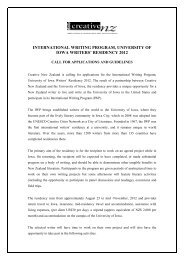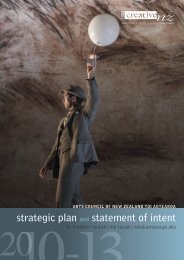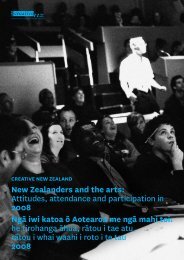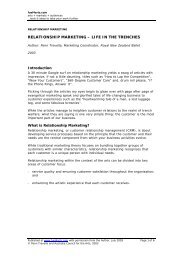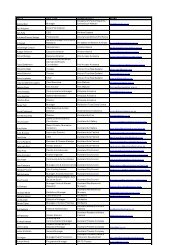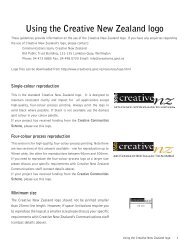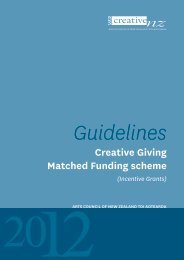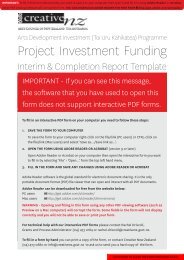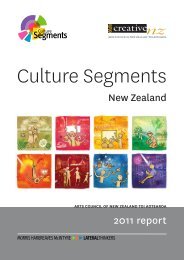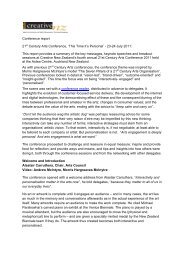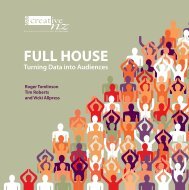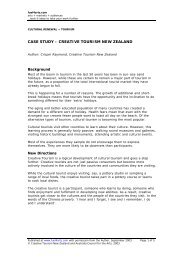1BUMS ONSEATSOffering a discount togroups is an efficient way ofgetting bums on seats. Butyou need to appreciate thatthis involves peopleorganising themselves to paytogether for a particularperformance. Make it easyfor them. Don’t put toomany restrictions on whatthey need to do to receivethe discount: e.g. instead ofthe group being ten or morepeople, make it six or more.Look at comparative events in the area and use their ticket pricing as a guide. People incities may be more used to paying higher prices for certain events than people in provincialareas. Demographically, Mäori, Pacific and other minority communities may be in thelower income bracket and be price-sensitive as a result. This will need to be considered ifyou are targeting these markets.Seek advice on ticket prices from the box office and venue managers. They deal directlywith the public and will have an understanding of audiences in their region.You should provide a range of prices, especially if you have a range of target markets withdifferent incomes. If you have a venue with variable seat and site-line quality, you can setprices accordingly.Don’t give so many ticket price options that you confuse your audience. A person makinga booking should be able to choose the best option on the spot. You risk losing them ifthey have to go away and think about it.Smaller productions or events often structure prices according to what people can afford to pay.For example:• $20 full price• $15 students, unemployed, senior citizens, group bookings• $10 youth, 12 years and under; special card holders (e.g. Fringe).When you’re setting ticket prices, remember that a person earning a wage won’t flinch at afew more dollars if they really want to attend. On the other hand, price is paramount forsomeone on a limited income.Keep your projected income and primary target in mind when you’re setting multiplepricing structures. Using the previous example, you might make the mistake of budgetingon an average price of between $15 and $20. However, if you’re more likely to attractstudents, you need to budget accordingly.• 75% of people attending are students at $15• 20% of people attending are full price at $20• 5% of people attending are youth at $10.If your expected attendance is 40% of total capacity of 100 seats over five nights, you canexpect 200 people to attend (i.e. 40 people per night). Your average ticket price is workedout like this:• 75% of 200 = 150 students Income: 150 x $15 = $2250• 20% of 200 = 40 people at full price Income: 40 x $20 = $800• 5% of 200 = 10 youth Income: 10 x $10 = $100Total income: $3150The average ticket price before tax or ticket agent fees are deducted is $3150 divided by200 people = $15.75. Once you’ve worked out what people will pay to see your show, youneed to be sure that it meets the income line in your overall production budget.If you find that the pricing is too low and the percentage of audiences you need to meetthe income line in your budget is too high, you may need to reconsider some crucialaspects of your production. Should you:• perform more days (if there is enough demand for your work)?• cut back on expenditure?<strong>Smart</strong> arts | Toi huatau12
ROUNDFIGURESOffering ticket prices to anexhibition at a few differentlevels is important.Discounts for groups,cheaper weekday visits andmulti-visit tickets are allpopular. Also try and keepthe price to a round figure:$10 looks, sounds and feelsbetter than $12, for example.You can get the extra $2from catalogue or othermerchandising sales. Givevisitors a basic printed guidewith their ticket, if possible,as part of their purchase. Itdoesn’t have to be a minicataloguebut it can beanother marketing tool,containing informationabout any eventssurrounding the exhibitionthat visitors might make areturn visit for.TIMINGITRIGHTThe timing of your showmay also be crucial to youraudience. A teenageaudience may enjoy amidnight performance butit’s unlikely to attract anolder audience, especiallyduring the week. Alsoconsider how people willget home after the show.Are buses still running?Another consideration isthe length of your show.What’s the stamina of youraudience in terms of thevenue’s comfort factor?• look for other avenues of income such as sponsorship or funding (remembering that theserequire a lot of lead-in time)?• reconsider your timing and postpone the event?Deciding what to charge for an exhibition is similar to deciding on the price to attend aperforming arts event: i.e. what’s the income required to offset some of the costs in yourbudget? Also ask yourself what a salary-earning adult or a family of four would pay to seea movie, play or concert, or have a cafe meal?Pre-booking isn’t an issue for exhibitions as people tend to buy their tickets at the venueon the day. For blockbuster exhibitions, airlines and other transport providers are oftenkeen to work out packages that include transport, accommodation and a ticket to theexhibition. But most visitors will be local people, who will decide on the day, or a fewdays in advance, to see the exhibition.Place<strong>Smart</strong> arts | Toi huatau13Your event should be staged at a time, date and place to suit your audience. Take, forinstance, a show aimed at school children. You may choose to perform your show bytouring to individual schools. Or you may decide to use an established theatre and attractschool audiences to your venue if the show is large and not easy to tour.Is your audience likely to come as part of a school group or are parents more likely tobring them? This will help you decide whether to run your season during the school termor the holidays. It will also influence your choice of venue.When you’re choosing a venue consider these issues:• How familiar are your target markets with the venue?• Are there any physical impediments? For example, an event targeted to senior citizenswill need to be in a venue with easy access, including wheelchair access.• What expectations does your venue engender about aspects such as show content, qualityor innovation? Staging a show at the SiLO or BATS Theatres creates differentexpectations to The Court or Downstage Theatres.• What facilities are there for your public? This includes seating, refreshments, toilets,heating, front of house staff. A youthful audience may be happy sitting on the floor of adraughty warehouse but an older audience isn’t likely to be attracted to this venue.• Have you informed your audience about the protocol particular to that venue? Forexample: no smoking/eating/drinking, cell phones turned off, no photography or videos,use of smoking/strobe light/offensive content on stage, admittance of latecomers’ policy,length of interval, reserved seating.• Is the venue easy to find or will people need a map to find it? Are there buses nearby?Where is the closest parking? Where can people get a drink?• Where do people book? Can they pay by eftpos, credit card or cheque?• Is it Occupational Safety and Health Services (OSH) compliant? What are the safetyprocedures of your venue in case of fire/earthquake? Will you be able to deal with anyhealth emergency? Visit www.osh.dol.govt.nz for more information.• Other legal compliances to be aware of include toilets, access for the disabled, and food tobe served with alcohol.• How many people does the venue seat and how does it impact on your budget?• What facilities are there for your production’s requirements? For example: lights, sound,size and height of stage, backstage facilities, what staff it comes with (technical support,box office and ushers).Planning a marketing strategy1



